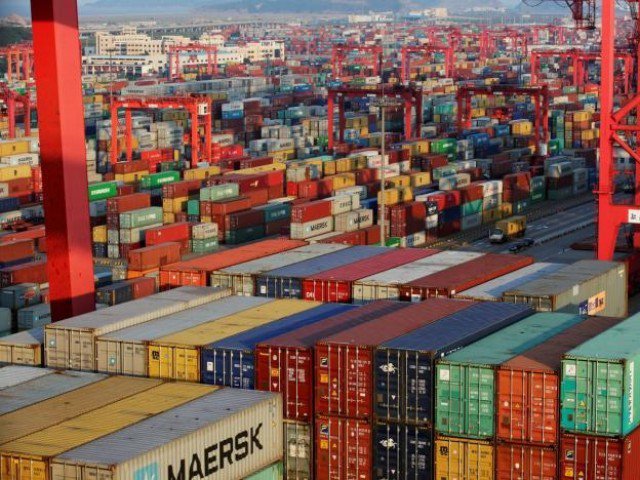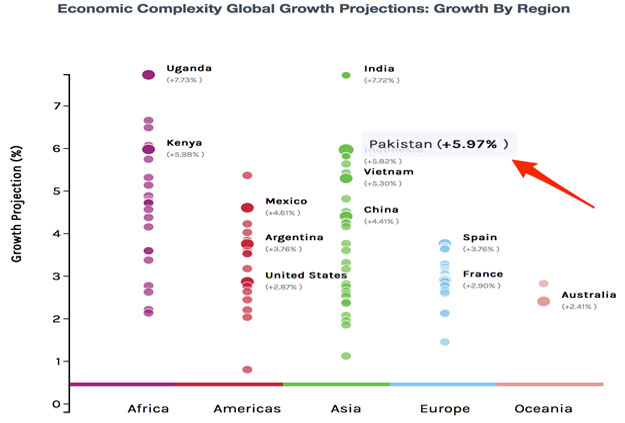
This is a one-point GDP increase as in the CID’s earlier projections, Pakistan GDP was set to grow at 5 per cent by 2025.
Although China's huge economy (current GDP at $12 trillion) cannot be compared with that of Pakistan (current GDP at $300 billion), Pakistan’s 5.97 per cent growth rate is above that of China, which is set to grow by 4.41 per cent.
 Pakistan’s 5.97 per cent growth rate is above China, which is set to grow by 4.41 per cent. PHOTO: THE ATLAS OF ECONOMIC COMPLEXITY, 2015. HARVARD CID
Pakistan’s 5.97 per cent growth rate is above China, which is set to grow by 4.41 per cent. PHOTO: THE ATLAS OF ECONOMIC COMPLEXITY, 2015. HARVARD CIDLed by Harvard Kennedy School, the research is called ‘The Atlas of Economic Complexity’.
The CID’s growth projections are based on the measures of each country’s economic complexity, which captures the diversity and sophistication of the productive capabilities embedded in its exports and the ease with which it could further diversify by expanding those capabilities.
According to the Harvard study, the economic complexity not only describes why countries are rich or poor today, but can also predict future growth — about five times more accurately than the World Economic Forum’s Global Competitiveness Index.
Pakistan’s neighbour India, on the other hand, is predicted to grow by 7.72 per cent, the world’s highest. The CID believes that the economic pole of global growth has moved over the past few years from China to neighbouring India and it is likely to stay there over the coming decade.
'Pakistan’s GDP growth expected to hit 9-year high in current fiscal year'
Except for India, Pakistan will beat all Asian economies in GDP growth. These also include giant Muslim economies.
Here are some regional countries (and their GDP growth) Pakistan will be ahead of:
Muslim and South Asian countries:
Indonesia 5.82 per cent
Turkey 5.64 per cent
Malaysia 4.82 per cent
Sri Lanka 3.77 per cent
Saudi Arabia 3.17 per cent
Bangladesh 2.82 per cent
UAE 2.41 per cent
Shanghai Cooperation Organisation (SCO) countries:
Tajikistan 3.61 per cent
Uzbekistan 3.32 per cent
Kazakhstan 2.65 per cent
Kyrgyzstan 5.77 per cent
Russia 2.60 per cent
According to the Harvard study, the central reason for income differences is know-how. Poor countries produce few goods that many countries can make because of the lack of know-how, while rich countries produce a greater diversity of goods, including products that few other countries can make.
Harvard’s leading research hub uses this fact to measure the amount of the know-how that is held in each economy.
A major trend that emerges from Harvard’s report is that the growth in emerging markets is predicted to continue to outpace that of advanced economies, though not uniformly.
Pakistan’s GDP growth expected at 4.9%: Moody’s
In addition to Pakistan, the CID projections are also optimistic about new growth hubs in East Africa and new segments of Southeast Asia, led by Indonesia and Vietnam. it also notes that economies based on commodity output face slower growth rates as commodity prices continue to remain under pressure.
With special economic zones (SEZs) being built under the China-Pakistan Economic Corridor (CPEC) project, it is an opportunity for Pakistan to move away from commodity output by producing value-added goods in joint ventures with Chinese firms and increase its exports. This way, Pakistan can have even faster income growth.
The Harvard growth projections are in line with other short, medium and long-term GDP growth forecasts for Pakistan.
HSBC: 5 per cent leading to 2050
IMF: 5.5 per cent leading to 2020
The World Bank: 5.8 per cent leading to 2019
The Economist: 5.7 per cent in 2017
In a bid to materialise this growth projection, what needs to be chalked out is a multi-pronged strategy. Pakistan needs to diversify its product capabilities. With likely new FDI inflows, Pakistani firms can go into producing value added goods both for domestic consumption as well as exports.
The firms, currently content with domestic sales turnover, need to introduce some percentage of exports to their strategic plans. Similarly, Pakistan’s agriculture sector needs to address its lack of sophistication and crop and distribution losses. The cumulative effect of even modest steps will help increase our GDP growth.
Wali Zahid is an award-winning journalist and a blogger. He is Pakistan futurist and writes on the economy. He tweets @walizahid.

1732184775-0/BeFunky-collage-(80)1732184775-0-165x106.webp)

1731933289-0/BeFunky-collage-(68)1731933289-0-165x106.webp)


1732179298-0/BeFunk_§_]__-(23)1732179298-0.jpg)

1732181665-0/Express-Tribune-(9)1732181665-0-270x192.webp)
1732178966-0/BeFunk_§_]__-(22)1732178966-0.jpg)
1732178488-0/Express-Tribune-(7)1732178488-0-270x192.webp)






COMMENTS (11)
Comments are moderated and generally will be posted if they are on-topic and not abusive.
For more information, please see our Comments FAQ